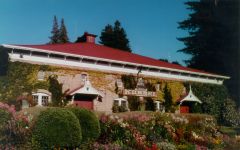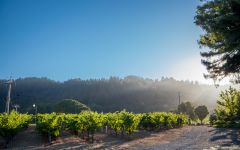Korbel Prosecco





Product Details
Your Rating
Somm Note
Winemaker Notes
Blend: 100% Glera







Since 1882, Korbel California Champagne has been America’s symbol of celebration. Made in the traditional Méthode Champenoise style, it is the #1 selling premium domestic sparkling wine in the US. Toast Life!
The Korbel story is more than a chapter in Sonoma County history. It is the saga of two enterprising families with pioneer spirits and old-world resourcefulness who envisioned the great opportunities emerging from the development of 19th-century America. Although generations apart, the Korbel and Heck families created and preserved a singular tradition of champagne-making excellence.
In the mid-1800s, America offered new hope to three brothers seeking to escape political unrest in their European homeland. The Korbels, born in the farmlands of the province of Bohemia (today’s Czech Republic), found the remote and rugged redwood country in Sonoma County irresistible.
Lured by the beauty and opportunity of the mountainous timberlands, the brothers eventually moved their families from San Francisco and settled in the Russian River Valley. F. Korbel & Bros. began as a manufacturing business in San Francisco that produced materials for the building industry. As their enterprise expanded, the brothers eventually acquired a sawmill and began a full-scale lumber operation near the town of Guerneville in Sonoma County. As Northern California’s lumber boom slowed, the Korbels turned their attention to farming prunes, beets, wheat, corn and alfalfa, and operated a commercial dairy on their Russian River Valley ranch. During this time, they planted their first vineyards and began experimenting with different grape varieties, including Pinot Noir — early evidence of the Korbels’ ambition to become champagne producers.
In 1882, the three brothers began a small winemaking operation at their ranch, and produced some 20,000 to 30,000 gallons of wine from their vineyard yields. Korbel wines were so well received that two years later the brothers closed their dairy, converted all of their ranch lands to vineyards, and devoted all of their energy to winemaking. A tradition that was to become a legacy was well under way.
The Korbel winery continued to grow throughout the 1880s. It was during this time that the Korbels sent for winemaker Frank Hasek in Prague to come to the United States to be their champagne master. Employing the time-honored French method of producing champagne, méthode champenoise, the Korbels quietly, but aggressively, experimented with Cuvées. By the late-1890s, the Korbels had shipped their first California champagnes, and by the turn of the century, KORBEL was an internationally known, award-winning label.
By the 1950s, as the second generation of Korbels successfully carried on the family tradition of producing fine California champagnes, the large winery building – constructed from the Korbel brothers’ own handmade bricks nearly 70 years earlier – had been expanded, and more vineyards had been planted. Eventually, the surviving Korbel family members decided that it was time to sell the winery and vineyards – but on very specific terms. They insisted that the new owner, Adolf Heck, carry on the Korbel tradition of producing fine California champagnes using méthode champenoise.
In 1966, Adolf invented and patented the first automatic riddling machine, which allowed each bottle of KORBEL California Champagne to undergo exact turns at precise times. This ensured consistent taste and quality in every bottle. Adolf Heck set out to pioneer what he described as “California-style” champagnes, which displayed more fruit and less yeast than European champagnes.
In 1984, Adolf’s son, Gary Heck, was named Korbel Winery’s Chairman of the Board. He has been active in nearly every aspect of the winery operation, from harvesting grapes by hand to sales administration.
KORBEL is a name that tells the unique story of two families – their dreams and dedication – and it stands for over 130 years of fine méthode champenoise California champagnes.

A term typically reserved for Champagne and Sparkling Wines, non-vintage or simply “NV” on a label indicates a blend of finished wines from different vintages (years of harvest). To make non-vintage Champagne, typically the current year’s harvest (in other words, the current vintage) forms the base of the blend. Finished wines from previous years, called “vins de reserve” are blended in at approximately 10-50% of the total volume in order to achieve the flavor, complexity, body and acidity for the desired house style. A tiny proportion of Champagnes are made from a single vintage.
There are also some very large production still wines that may not claim one particular vintage. This would be at the discretion of the winemaker’s goals for character of the final wine.

One of the world’s most popular and playful sparkling wines, Prosecco is a specialty of northeastern Italy, spanning nine provinces of the Veneto and Fruili-Venezia Giulia regions. A higher-quality version of Prosecco wine that must meet more stringent production requirements is known as Prosecco Superiore and must come from the more rugged terrain between the towns of Valdobiaddene and Conegliano. Prosecco can be produced as a still wine, a semi-sparkling wine (“frizzante”), or a fully sparkling wine (“spumante”)—the latter being the most common. While Prosecco wine is typically produced in a “brut” (dry) style, its fresh and fruity character makes it seem a bit sweeter than it actually is. “Extra dry” styles, incorporating higher levels of residual sugar, are quite popular, however.
Prosecco wine is made from the Glera grape, which was formerly and confusingly called Prosecco, these wines are notable for pleasant flavors of peach, pear, melon, green apple, and honeysuckle. Lower pressure during the carbonation process (also called the tank method) means that the bubbles are lighter and frothier than in Champagne or other traditional method sparkling wine, and less persistent. Prosecco is also a great choice to blend with orange juice for mimosas for a classic brunch beverage.
